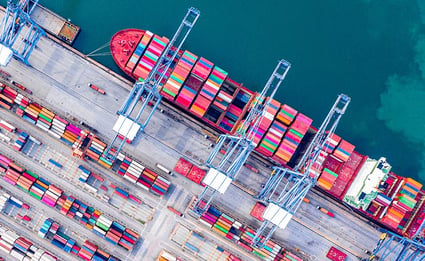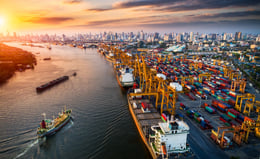5 Simple Steps to Increase Freight Capacity
Keith LaBotz - October 07, 2021

Making the Most of the Transportation Capacity Crunch
The transportation capacity crunch is here to stay. Many won’t understand what’s happening, but you will after reading this. You’ll also learn about the strategic opportunity.
The Future of Freight
Do you want to know the future of freight? Look at the final stretch of 2021, and you’ll see it: transportation demand exceeds capacity, ports can’t move freight, driver and container shortages, equipment failures, and soaring fuel prices. All of this while the peak season for retail shipping expects an increase of at least 7% over 2020, according to Deloitte, Bain, and Mastercard.
The future of freight is the crunch. If we want to understand the future, we need to understand the past. Let’s find out what this crunch is about.
The Sputter That Became a Crunch
The story began decades ago when supply chains began building infrastructure around a belief in ever-increasing stability, including the transportation networks servicing them. That ended when rulers tried to stop a microbe by collapsing the supply chain with lockdowns.
When that didn’t work, the rulers ended the lockdowns, and the supply chains restarted. The ensuing volatility overwhelmed the old systems, but they sputtered back towards equilibrium thanks to quick fixes. Freight began filling the coffers in transportation networks, and things were looking good.
Then the transportation network started sputtering. Everyone knew about a driver shortage; finding drivers and trucks was challenging at times, a sputter here and there.
Suddenly the crunch appeared. It did not play by the old rules or cooperate with the old systems. It even had the power to paralyze supply chains. What was this crunch, and where did it come from?
How the Crunch Began
Warnings about a growing driver shortage were ignored over the past several years, long before anyone heard of COVID. The crunch was predictable, inevitable, and the industry was counting on gradual adjustments spanning several years to mitigate risks.
When the rulers performed their experiment, they didn’t realize the forces they were playing with, and it compressed the future timeline into a single point in time, the present. It set off an explosion like the Big Bang, and that’s how the crunch came into existence. I’m not a scientist, so I can’t explain this, but this crunch gets energy from truck drivers who quit driving.
Once the lockdowns began, many truck drivers stayed at home for a year and decided to leave life on the road behind and find work close to home. Others decided to take a long vacation from driving until government regulations and the supply chain stresses ease up.
While they enjoy the good life, these guys don’t realize that the crunch is getting its power from them. The crunch gets more powerful every time a driver quits. Weird huh? It gets even weirder.
The End of the World?
Some people think the crunch has the power to destroy the entire supply chain. Multiple polls report 25% to 46% of American truck drivers will quit in the event of a government-mandated COVID vaccine. If this were to transpire, we’d see a supply chain crisis beyond anything experienced from lockdowns. Following the initial losses, others will leave transportation for less turbulent waters. Those remaining will face a wave of bankruptcies that sets off another cycle of losses. It’s a perfect storm for a self-fulfilling prophecy. Let’s hope it stays sunny.
The End.
The Crunch is Here to Stay
The moral of our story is this: No matter how this story ends, the crunch is here to stay, and here’s why:
- Lockdowns were an experiment that got out of control and created the crunch.
- The crunch is a long-term, systemic problem that grows stronger when drivers quit.
- No political action can correct transportation capacity, including emergency bailouts.
- We must accept and adjust to the crunch, and we find ways to minimize its impact.
How to Spot and Stop TROUBLE
Many companies looked to ERP vendors for guidance and approached the supply chain emphasizing the front end of the business: production, order management, CRM, inventory, S&OP. Transportation was an after-thought in ERP and most enterprises, and the systems supported narrow, predictable transportation scenarios with a bias towards bulk freight. This is the polar opposite of transportation in the crunch, and it spells TROUBLE.
In the crunch, a transportation process must be fluidly managing transportation services across a wide range of delivery options, or it will undermine the enterprise. Here are some symptoms to look for in a business enterprise that indicate change is required:
- Logistics execution fails to support corporate objectives and customer requirements.
- TMS is not directly integrated with electronic marketplaces and load boards.
- Small parcel, LTL, truckload, ocean, and other modes are managed by different systems.
- Carrier selection is not automated, and it cannot choose the optimal carrier based on delivery date and time, least cost, mode, packaging, customer, and product.
- Cost comparisons between multiple service levels and modes are not available.
- Consolidation pricing is not available from order entry and online shopping carts.
- Pickups and tendering are not automated.
- Carrier invoices are not received, audited, and paid electronically.
- Information silos exist in the business enterprise, separating ERP, WMS, TMS, SCM, and carrier shipping and tracking data.
- Transportation tracking numbers, shipment location, and freight invoices are not accessible by SKU serial numbers and order line items.
5 Steps for Increasing Freight Capacity
Now that I’ve terrified you and we know where we are with the crunch, there are five things your company can do to increase available transportation and gaining a first-mover advantage.
1. Adjust Your Beliefs and Expectations
Let go of past beliefs about transportation, the supply chain, and business expectations. Beliefs must always reflect current supply chain realities, and my own belief is the transportation capacity crunch is not going away, possibly for years. You may reach a different conclusion and whatever you decide, let your belief shape your outlook and plan accordingly.
- Recalibrate KPIs, service commitments, budgets, and forecasts to match the new norms.
- Be careful with transportation forecasting - historical metrics are no longer valid and; there is a risk of even less capacity given unstable political leadership in the US.
- Expect longer unloading times at ports to reduce fleet capacity by 10-20%, and increase the lead time by 20-30%.
- Plan on doubling ocean and truck transportation expenses. (my opinion)
2. Adjust Your Supply Chain Model
A supply chain model reflects your beliefs about supply chain realities, and when beliefs change, your supply chain model changes. Companies with a core competency in transportation can expect to fare better going forward, but only if transportation is actuated at the core of their supply chain process. A transportation-centric supply chain model will put transportation at the core of your business model where it belongs.
- Increase Visibility
Dealing with fluctuating capacity affects the reliability of delivery commitments. The driver shortage has created a capacity shortage for shippers and a reliability shortage for their customers, and customers have a strong desire for greater reliability.
A 2020 report shows customers are tolerant of shipping delays if shippers proactively relay shipment status. Only 19% reported these updates to occur to their satisfaction - this is a clear opportunity for shippers, and increasing visibility by monitoring shipment status (ETA, exceptions, location, delivery details) can fulfill the demand. Visibility to execution-level logistics processes can also reduce exceptions that compromise on-time delivery. In a marketplace where reliability has a premium, increasing visibility adds value and creates a competitive advantage.
4. Optimize Transportation
Transportation was already a dynamic activity, and the crunch might increase queries and decisions by 50%. Intelligent solutions are essential for managing a dynamic environment, and this will become more crucial now. Solutions like flexis Transportation Planning and Scheduling and Dynamic Routing can optimize transportation from initial planning through final delivery and reduce labor costs.
5. Strengthen Carrier Partnerships
It’s a carrier’s market. The most attractive shippers get attention, and that’s what your company must present. Meet with transportation partners to find out what your company can do to make your operation more attractive.
- Look at process improvements for dock operations, packaging, pickup and delivery windows, and freight payment terms.
- Provide carriers with the opportunity to pick up larger freight volumes per pickup and shipments in more desirable lanes.
- Offer your best forecast on expected inbound and outbound volumes so each carrier can optimize agreements for both parties.
The Strategic Opportunity
A global reset like this has never occurred, opening a unique window for shippers to differentiate logistics in their market niche. Everyone is in the same predicament with backlogs, late shipments, and higher costs at this early stage. First-movers who follow the 5 steps will stand out by increasing service levels and their bottom line relative to competitors.
Summary
The capacity crunch is here to stay - it is our future, and it challenges how we think about and engage transportation in the supply chain. It’s another opportunity to improve supply chain performance through the power of belief, enabling us to build better solutions that create a competitive advantage.
I hope this gives you a few practical ideas and a positive outlook for the future.
If you want to learn more get your Guide to Logistics 4.0
In this Guide you will learn:
-
Why a strategic process in transportation planning is a top priority for digitalization
-
What megatrends will increase supply chain volatility
-
How to manage it
LATEST POSTS
- Understand Circular Economy in The Manufacturing Industry
- How Can Industry 4.0 IT Integration Be Achieved Smoothly?
- The Significance of Order Sequencing in Discrete Manufacturing
- How to improve your Supply Chain Management: The Power of Control Towers
- Optimizing Human Resource Scheduling in Manufacturing: A Technological Approach



